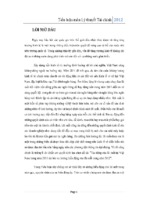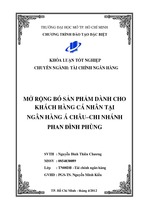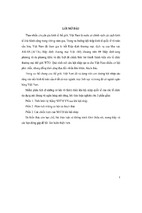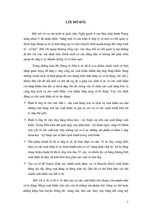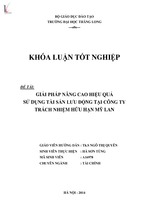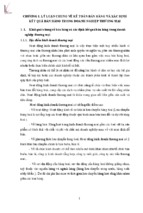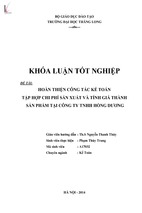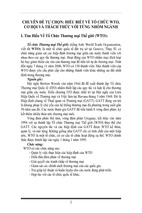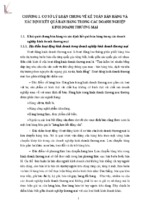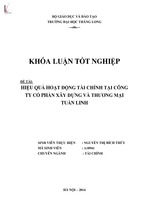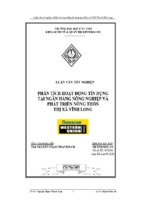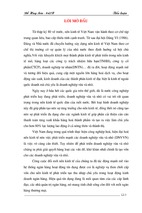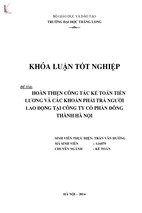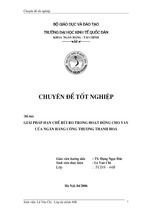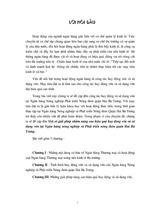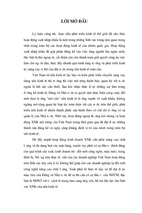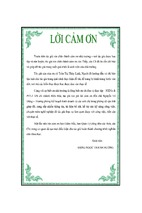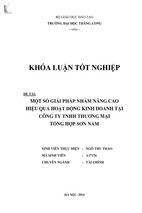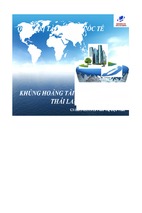ACKNOWLEDGEMENT
The process of writing this graduation thesis has provided me interesting experience. It
would not have been completed without guidance, support and motivation from many
people whom I would like to express my gratitude and appreciation.
First of all, I would like to thank my supervisor, Mr. Nguyễn Hồng Quân. Without his
in-depth knowledge and careful guidance, I might not produce this work.
Secondly, I would like to say thanks all the managers and staffs of Mai Linh North
Joint Stock Company, for their cooperation that helped and inspired me in this writing.
Last but not least, I would also like to give my warm thank to the authors, researchers,
scientists who provided me such valuable materials for my research.
Hanoi, May 14th, 2015
CONTENT
LIST OF FIGURES
LIST OF TABLES
CHAPTER 1: INTRODUCTION............................................................................................. 1
1.1.
Background for the research...................................................................................... 1
1.2.
Research objectives................................................................................................... 2
1.3.
Research scope.......................................................................................................... 2
1.4.
Research questions..................................................................................................... 2
1.5.
Research method........................................................................................................ 3
1.5.1.
Literature review.................................................................................................... 3
1.5.2.
Empirical study...................................................................................................... 3
1.6.
Thesis structure.......................................................................................................... 4
CHAPTER 2: LITERATURE REVIEW.................................................................................. 5
2.1. Organizational restructuring.......................................................................................... 5
2.1.1. Definitions.............................................................................................................. 5
2.1.2. Reasons................................................................................................................... 5
2.1.3. Types of organizational restructuring....................................................................... 7
2.1.4. Models.................................................................................................................. 10
2.1.5. Communication in restructuring process................................................................20
2.2. Employees under restructuring conditions...................................................................26
2.2.1. Employee attitude.................................................................................................. 26
2.2.2. Employee engagement.......................................................................................... 27
2.2.3. Employee morale.................................................................................................. 33
CHAPTER 3: RESEARCH PURPOSE.................................................................................. 36
3.1. Overview of Mai Linh Group...................................................................................... 36
3.2. Vision, mission and core values................................................................................... 37
3.3. Restructuring process of Mai Linh Group from 2010 to 2014......................................37
CHAPTER 4: RESEARCH METHODOLOGY..................................................................... 42
4.1 Research design............................................................................................................ 42
4.2 Treatment of data.......................................................................................................... 43
4.2.1 Data collection....................................................................................................... 43
4.2.2 Data analysis.......................................................................................................... 44
4.3 Questionnaire design.................................................................................................... 45
4.4. Pilot study.................................................................................................................... 46
4.5. Sample population....................................................................................................... 47
4.6. Response rate............................................................................................................... 48
CHAPTER 5: RESULTS AND INTERPRETATION.............................................................49
5.1. Analysis of biographical information...........................................................................49
5.2. Employee involvement in the process.......................................................................... 51
5.3. Employee attitudes after the restructuring process.......................................................53
5.5. Communication process and strategy during restructuring...........................................57
5.5.1. Forms of communication used during restructuring...............................................59
5.5.3. Other findings....................................................................................................... 60
CHAPTER 6: CONCLUSIONS AND RECOMMENDATIONS............................................62
6.1. Main findings.............................................................................................................. 62
6.1.1 Employee involvement in the restructuring process................................................62
6.1.2 Impact of restructuring on employee attitudes........................................................62
6.1.3 Impact of restructuring on employees’ morale........................................................63
6.1.4 Communication process and strategy during restructuring......................................63
6.2. Problems and limitations.............................................................................................. 64
6.3. Recommendations....................................................................................................... 64
6.4. Opportunities for further research................................................................................ 66
REFERENCES...................................................................................................................... 67
APPENDIX........................................................................................................................... 70
Appendix 1: Questionnaire covering letter.......................................................................... 70
Appendix 2: Questionnaire covering letter in Vietnamese language....................................71
Appendix 3: Research questionnaire................................................................................... 72
Appendix 4: Research questionnaire in Vietnam language..................................................79
Appendix 5: Results of questionnaires................................................................................ 84
LIST OF FIGURES
Figure 2.1: Nadier & Tushman’s congruence model………………………………….14
Figure 2.2: John Kotter’s eight-step model…………………………………………....18
Figure 2.3: The International Survey Research’s Model……………………………...31
Figure 3.1: The organizational chart of Mai Linh group in 2010……………………..39
Figure 3.2: The organizational chart of Mai Linh group in 2014……………………..40
Figure 5.1: Gender distribution of sample…………………………………………….49
Figure 5.2: Age distribution of sample………………………………………………..50
Figure 5.3: Responses by number of years employed…………………………………50
Figure 5.4: Forms of communication predominantly used during restructuring……...59
LIST OF TABLES
Table 3.1: Financial statement of Mai Linh Group from 2006 to 2014……………….37
Table 3.2: The number of employees working for Mai Linh Group from 2010 to 2014…38
Table 5.1: Employee Involvement in the Process……………………………………..52
Table 5.2: Employee Attitude after the Restructuring………………………………...54
Table 5.3: Employee morale after restructuring………………………………………56
Table 5.4: Communication process and strategy during restructuring………………..58
1
CHAPTER 1: INTRODUCTION
1.1.
Background for the research
Change has become inevitable in today’s fast paced and increasingly complex world.
Besides to external factors such as high speed technological developments, economic
factors and globalization, a conceited change inside also fuels the change in the
business environment. As a result, organizations need to keep up with rapid
developments in the business environment to survive. This requires organizations to be
open and willing to change and once the organizations make up their mind to undergo a
radical change, significant effort is required to effectively manage this change.
Regarding Mai Linh, from 2007, it started to fall down into the hot growth trap by
rushing to inject cash in the business fields such as education and real estate which
unrelated to their main business, namely transportation service. Meanwhile, the modest
income was insufficient to cover expenses and then led Mai Linh into the statuses of
the insolvency and the liquidity exhaustion. In 2010, the annual shareholders' meeting
of Mai Linh group announced to embark on a process of restructuring the organization
after suffering negative net profit after tax three years in a row from 2007 to 2009. The
group would return to the core business. This process, like many other restructuring
processes, has had some casualties in terms of people in which some had to leave the
organization while others were asked to pursue something else within the group. This
created a lot of uncertainty amongst many employees, particularly those that were from
the redundant unit. This has been the case despite the repeated assurances from the
management that this was not a cost-cutting exercise, and therefore, staff should not be
afraid that they may lose their jobs.
2
1.2.
Research objectives
Reviewing contemporary literature to identify the restructuring strategies for
organizations
Clarifying the organizational restructuring process employed by the selected
organization
Evaluating the effects of the organizational restructuring process has had on the
employees
Comparing the literary theory with the restructuring process followed by the
chosen organization
Recommending the most appropriate strategies for the organizational restructuring
process
1.3.
Research scope
There are many interesting issues and topics around restructuring process and thus it is
important to focus on only chosen issues. The main issue in this thesis is to learn more
about effects of restructuring on employees' attitude, engagement and morale as well as
gain deep understanding of communication process during restructuring to help change
project managers more effectively plan and implement change projects.
The study is carried out at a child company of Mai Linh group named Mai Linh
North Joint Stock Company. In addition, due to the topic of this thesis, the author
concentrates on the period of restructuring of Mai Linh group from 2010 to 2014.
1.4.
Research questions
Main Problem
Although Mai Linh’s restructuring process affects all aspects of the group, the author
pays more attention to the question related to what strategies this organization can
employ to effectively restructure its business without compromising the employees’
morale.
3
Sub-problems
An analysis of the main problem allows identification of the following sub-problems:
Sub-problem one:
What are the restructuring strategies that the related literature has been discussed which
can help an organization in effectively implementing their restructuring process?
Sub-problem two:
What restructuring strategies did the chosen business employ?
Sub-problem three:
What were the influences of the restructuring process on employees’ morale at the
selected organization?
1.5.
Research method
The subsequent methodologies were applied for this study
1.5.1. Literature review
Some restructuring strategies such as Burke-Litwin model of organizational
performance and change and John Kotter’s eight-step change model, based on a related
literature study of the newly-updated possible sources, were revised to help the
organization effectively implement its restructuring process. A theoretical foundation
for this study also came from some research reports and journals like “The effect of
downsizing on morale and attrition” and “Work and Occupations”.
1.5.2. Empirical study
A survey was conducted among certain employees of Mai Linh North Joint Stock
Company. Moreover, the researcher constructed a questionnaire to identify influences
the recent restructuring process on its morale.
4
Regarding a sample for this study, 30 employees of Mai Linh North Joint Stock
Company including 11 taxi drivers and 19 office-based employees were selected as a
sample for the study.
1.6.
Thesis structure
The study includes the following chapters:
Chapter 1: Problem statement and outline of the study
Chapter 2: Theory of organizational restructuring
Chapter 3: Description of organizational restructuring at Mai Linh Group
Chapter 4: Research methodology and analysis of biographical details
Chapter 5: Analysis and interpretation of results
Chapter 6: Summary, conclusions and recommendations
5
CHAPTER 2: LITERATURE REVIEW
2.1. Organizational restructuring
2.1.1. Definitions
The concept of "organizational restructuring" has various definitions. To be more
specific, organizational restructuring is “planned changes in a firm’s organizational
structure that affect its use of people” (Cascio, 2002, p.4). On the other hand,
Greenberg and Baron (1995) define this concept as the altering of size and basic
configuration of the organizational chart. Organizational restructuring can also be
considered by Hammer and Champy (1993) as the fundamental rethinking and radical
redesign or change of business processes (such as the process of receiving a sales order
to billing the customer and receiving and payment), in the way in which an
organization performs its business activities, to bring about dramatic improvements in
critical, contemporary measures of performance, such as cost, quality, service and
speed.
2.1.2. Reasons
Regarding reasons of organizational restructuring, many organizations these days often
take part in activities which are designed to improve their organizational effectiveness,
which then would create a need for the organizations to restructure to enhance the
process. Also, organizational restructuring may refer to different forms such as the
addition of new product lines or markets, mergers, acquisitions and cost reduction
exercises. These various forms of restructuring often confront a common challenge that
they require human resources to be changed so that an appropriate staff level can be
maintained in a corporate structure to foster both the proactive and reactive capacity of
the organization to meet new demands in the marketplace. Therefore, the restructuring
process would cause either upsizing or downsizing the staffing levels. In either case,
the result will involve the rightsizing and the reorganization as well as realignment of
workflows. Especially, to bolster the productive and effective use of resources, lines of
6
responsibility and authority require to be structured (American Institute of Certified
Public Accountant, 2004).
Organizational restructuring, by definition, involves fundamental changes in the
organization and naturally causes suspicions and uncertainty among workers.
Companies need to manage this process very carefully to minimize pain and
disruptions that may negatively effect on the business (American Institute of Certified
Public Accountant, 2004).
According to Byars (1992), the need to restructure may be triggered by various forces
such as the business expansion of the organization, products or customer base diversity,
expansion of product lines through acquisitions, and entering into a joint venture with
another company in a bid to access bigger markets. The following are the reasons
generally given by most organizations for reorganizing:
-
To increase profitability of the company;
-
To foster productivity;
-
To develop competitive advantages;
-
To enhance the ratios of the balance sheet;
-
To improve growth rates; and
-
To strategically shift the direction and focus.
Byars (1992) also suggests that there are many factors that influence the structure of
the organization, but the organizational structure cannot be altered every time when
one of these factors changes because perpetual restructuring will lead to a state of
chaos and confusion within the organization. The organizational restructuring is also
not a solution to inferior products offering, bad strategies applying or filling of
positions with unsuitable individuals. Organizations should set relevant objectives that
will measure the success of the restructuring process. These objectives should always
be in sync with the goals of the other parts of the corporate strategic plan.
7
Under governments’ pressure, organizational restructuring can take place in stateowned enterprises, especially in countries in which state-owned companies dominate.
Based on Foreign & Commonwealth Office of the UK (2014), Vietnam has attempted
to reduce the number of its state enterprises date back to1990s. Although such
companies have employed high total capital of government, business efficiency is
negative when many of them have suffered from negative profits and even accounted
for many non-performaning loans. During the restructuring process of Vietnamese state
enterprises, the State Capital Investment Corporation, established in 2005, has been
authorized to purchase shares and become the strategic investor when an initial public
offering fails. The State Bank of Vietnam will be involved too, to acquire divestments
from the financial and banking businesses of state-owned enterprises.
Organizations today are also increasingly encountering intense competition,
demanding customers, economic pressures and financial crises. To effectively deal with
the potentially negative effects of these situations, they need to devise suitable
strategies, decrease operating costs, enhance the quality of both products and services
as well as increase their reactive capacity to respond to new opportunities in the market
place.
2.1.3. Types of organizational restructuring
Cascio (2002) suggests an approach named ‘responsible restructuring’ as an alternative
for the traditional method that requires the decline in the number of employees with
painful consequences that follow. This new term, however, depends on the
management view of employees. Management who considers their employees as costs
to be reduced tends to reduce their workforce when restructuring. They always look at
an irreducible core of workers that the business has to make sure that minimum figure
of employees is maintained. On the other hand, management who view their employees
as assets to be nurtured and developed is more likely to be responsible restructurers.
They constantly seek new ways of doing business that will ensure that employees are
utilized more efficiently and effectively. While the downsizers often consider workers
8
as commodities that can be changeable and substituted for one another, the responsible
restructurers view their employees as sources of renewal and creativity as well as
having potential to grow the business.
Cascio (2002) also mentions that organizations following a pure employment
downsizing approach are likely to focus on altering the number of employees without
altering the manner in which the work is done. This approach hardly brings about longterm effects that management had been looking for. On the other hand, the
organizations that pursue a ‘responsible restructuring’ approach tend to depend on their
employees to offer continuous competitive advantage and accept a wide range of
practices. The following are some of such practices:
-
Adopting training programs to develop employees’ skills and knowledge;
-
Sharing of information;
-
Encouraging their employees to participate in the design and execution of work
processes;
-
Adopting organizational structures that are changed;
-
Promoting partnerships between employees and management;
-
Adopting a customer centric approach in their design and delivery of products
and services; and
-
Remunerate employees according to their skills and organizational performance.
These practices must be applied together as a system in order to bring about good
results. This approach to restructuring does give rise to enhanced performance and
productivity amongst workers as well as longer-term financial performance for the
organization.
According to Senge et al. (1999) during the restructuring process of an organization, its
employees do require some help to effectively deal with problems cropping up.
Restructuring must be viewed as an ongoing process rather than a project. The
9
successful implementation of change requires organizations to change their mindset
and this does not happen overnight. Employees must not only be given both intellectual
and financial tools needed to cope with future business challenges, but be assisted in
starting to see the business environment differently. This will help them to comprehend
the need for change in their organization and this will naturally make them more
supportive of change.
Organizational restructuring may also involve changing the size and the basic
arrangement of the organizational chart. It may involve downsizing which is a process
of reducing the number of employees required to perform effectively. This process is
not directed only at retrenching workers, but also at ensuring that the newly designed
structure absorbs only the number of employees required, nothing more and nothing
less. It is therefore also referred to as rightsizing.
Organizations can also restructure through outsourcing of the non-core parts of their
business to pay all its attention to core business functions that are enshrined in its
mission. Depending on the outsourcing agreement, the company to which the business
is outsourced may employ the same workers who were manufacturing the products or
services from the outsourcing company and vice versa. This form of restructuring may
not necessarily lead to the loss of jobs (Greenberg and Baron, 1995).
According Foreign & Commonwealth Office of the UK (2014), restructuring process
can take place in state-owned enterprises by equitization. Equitization refers to the
privatization of a wholly-state-owned enterprise by selling a part or all of the assets and
liabilities of the state-owned enterprises to the private sector, thus transforming the
state-owned enterprises into a joint-stock company. As a result, the government may or
may not be a shareholder of state-owned enterprises. There are some objectives when
introducing equitisation of the state-owned enterprises in Vietnam. The first aim is
improving economic efficiency of state sector when some state-owned companies in
Vietnam continue to have negative influences on economic performance and to worsen
problems with public investment, the banking sector and fiscal sustainability.
10
Specifically, thanks to closer relationships with government, many unproductive
government-owned corporations can gain access to public contracts and carry out the
majority of development and infrastructure projects. They also diversified into noncore areas during investment boom but did not succeed in these businesses, and
therefore, took up many non-performing loans held by Vietnam’s banks, which would
be guaranteed by the state. As a result, equitisation could reduce deficits of state budget
owing to subsidies and bearing state-owned enterprises’ losses and utilize any available
capital resources in the economy. Another goal of equitisation is mobilizing all of
capital resources available for investment to improve management, technologies and
employment in the state sector. Last but not least, equitisation helps employees to be
shareholders of their enterprises and strengthens the relationship between employees
and shareholders.
2.1.4. Models
Contemporary literature reveals various change models that managers can use to
implement changes in their organizations. These models can assist not only in
managing the changes happening in an organization, but can also help in anticipating
and identifying possible key issues that are critical in managing change process.
2.1.4.1. Burke-Litwin causal model of organizational performance and change
The Burke-Litwin model is an open system model, illustrating the interaction between
the organization and factors in the external environment. Thanks to this, management
can gain in-depth understanding of problems which may happen when restructuring is
brought about by the serious changes. The Burke-Litwin model also entails other
aspects such as structure, systems, management practices, climate, individual skills,
and motivation that are critical in understanding and simulating transition.
This model was first introduced by Warren W. Burke and George Litwin in 1989 and
further refined in 1992. The content of this includes both what and how: “what
organizational dimensions are required to successfully change and how these
dimensions should be connected causally to reach the change goals” (Burke & Litwin,
11
1992, p. 525). Both authors employ theoretical and empirical insights to the model,
making it pragmatic for both empirical researches as well as guiding and assessing
change initiatives.
The Burke-Litwin Model encompasses 12 components, each presenting an important
task or concept within the framework of an organization. The elements and their
definitions, as described by Burke and Litwin (1992) are listed below.
-
External environment
The external environment is any outside condition or situation that affects the
organization's performance such as markets, legislation, competition and the economy.
All of these will have consequences for organizations, and, it is vital that change
managers continually scan the environment for issues that will affect the restructuring
process.
-
Mission and strategy
An organization’s mission articulates its reason for existing. It is the foundation upon
which all activity should be built. The strategy then sets out, in broad terms, how the
organization will go about achieving its mission. Very often, the strategy will be
developed in light of environmental change, and will have a significant impact on the
work of employees. So, change managers need to understand change in strategy and be
able to communicate the implications to their staff.
-
Leadership
Leadership considers the attitudes and behavior of senior colleagues and how these
behaviors are perceived by the organization as a whole. The way in which change is
implemented and accepted through the organization will be largely influenced by the
top team.
-
Culture
Organizational culture can be described as “the way we do things around here”. In
other words, culture of an organization is the collection of overt and covert rules,
12
values, and principles which endure and guide organizational behavior. Culture change
does not happen overnight. It evolves over time as a result of many other changes in
the organization.
-
Structure
Structure is the allocation of functions and human resources into specific areas and
levels of responsibility, decision-making authority, communication, and relationships to
make sure effective implementation of the organization‘s mission and strategy.
-
Management practices
Management practices are managers’ actions in the normal course of events to use the
human and material resources at their disposal to conduct the organization‘s strategy.
-
Systems
Systems are standardized policies and mechanisms that facilitate work, primarily
manifested in the organization‘s reward systems, management information systems
(MIS), and in such control systems as performance appraisal, goal and budget
development, and human resource allocation.
-
Climate
This concept considers employees’ perception of their current colleagues and working
environment. Changes tend to invoke a wide range of emotional and political responses
from staff to the immediate working environment, so they need to be managed
sensitively. This is particularly the case where change involves moving location, a
change in personnel, or a change in terms of conditions of service, such as working
hours.
-
Task requirements and individual skills/abilities
Task requirements and individual skills/abilities refer to the required behavior for task
effectiveness, including specific skills and knowledge for employees to fulfill their
work for which they have been assigned and for which they feel directly responsible.
13
-
Individual needs and values
Individual needs and values represent the specific psychological factors that provide
desire and worth for individual actions or thoughts.
-
Motivation
Motivation is aroused behavior tendencies to move toward individual and
organizational goals, take needed action, and persist until satisfaction is attained.
Motivation plays an important role in effective change. The real challenge is to retain
motivation throughout a change project, particularly when change is often not wellreceived by those affected.
-
Individual and organizational performance
The concept of individual and organizational performance describes the result or
outcome as well as the indicator of effort and achievement such as productivity,
customer satisfaction, profit, and quality. (Burke & Litwin, 1992, pp. 531-533)
2.1.4.2. Nadler and Tushman’s congruence model
The model for managing change developed by Nadler and Tushman is based on the
understanding the factors that have impact on the success of the change process. The
congruence represents an organization with its sub-systems, which sorts out and
translates the changes from the external environment. The organization (the system)
diagnoses the inputs from internal and external change drivers, puts them into the
transformational process (composed of sub-systems) and acquires outputs that can be
used at the individual, team, and organizational level. The sub-systems are not
independent from each other. The interactions and dependencies among sub-systems
are fundamental for the success of the change management process.
14
Figure 2.1: Nadier & Tushman’s congruence model
Source: David A. Nadler and Michael L. Tushman, 1997
The organization contains four key elements: the work; the people who perform the
work; the formal organizational arrangements that provide structure and direction to
their work; and the informal organization, sometimes referred to as culture or operating
environment, that reflects their values, beliefs, and behavioral patterns. The real
challenge of organizational design is to select from a range of alternatives the most
appropriate way to configure the organizational components to create the output
required by the strategy. To do this, it is essential to understand each organizational
component and its relationship to the others.
-
The work
This general term presents the basic and inherent activities engaged in by the
organization, its units, and its people in furthering the company’s strategy. Any analysis
from a design perspective has to start with an understanding of the nature of the tasks
to be performed, anticipated work flow patterns, and an assessment of the more
complex characteristics of the work–the knowledge or skills it demands, the rewards it
offers, and the stress or uncertainty it involves.
15
-
The people
It’s important to identify the typical characteristics of the employees responsible for the
range of tasks involved in the core work: knowledge and skills they bring to their work,
their needs and preferences in terms of the personal and financial rewards they expect
to flow from their work, their perceptions and expectations about their relationship
with the organization, their demographics related to their work?
-
The formal organization
This concept refers to the structures, systems, and processes of an organization to
support its people and the work they do and to coordinate their activities to reach the
strategic objectives.
-
The informal organization
This term presents informal and unwritten guidelines that exert a powerful influence on
people’s collective and individual behavior. To be more specific, the informal
organization consists of a pattern of processes, practices, and political relationships that
embodies the values, beliefs, and accepted behavioral norms of the individuals who
work for the company.
In terms of an effective and successful change process, Nadler and Tushman propose
that managers should administer all four components at the same time. They say that
the source of resistance to change could result from managers who ignore these subsystems and the interaction among them.
2.1.4.3. Nine-phase change process model developed by Anderson and Anderson
The most comprehensive model of organizational change is a Nine-Phase Change
Process Model developed by Anderson and Anderson (2001). The authors of this model
believe that this model “represents a full stream roadmap for getting your organization
from where it is to where it wants to be”. The model deals with twenty-one aspects of
change activities.
- Xem thêm -

